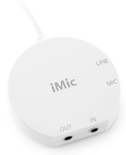
| Home |
| Join/Renew Online! |
| About NCMUG |
| Membership |
| Newsletter |
| Special Interest Groups |
| Mail Lists |
| Volunteering |
| Book Library |
| Member Sites |
| NCMUG FAQs |
| Mac FAQs |
| Contact Us |
| Site Map |

 iMic: USB Audio Interface
iMic: USB Audio Interface
iMic: USB Audio Interface
Retail Price: $39.99
Do you have some old LPs or 45s that you want to convert to MP3s? How about those old audio cassettes with your children’s, parents’ or grandparents’ voices you want to save to CD or use in your next iMovie?
Recently I was given the chance to play with Griffin Technology’s iMic, a USB audio input/output device that captures audio from a stereo, radio, musical instrument, microphone, VCR or cassette player. The iMic connects to your device of choice by a standard 1/8" stereo input jack and interfaces with audio connectors such as RCA, 1/4" and XLR jacks.
Looks pretty simple. Just two 1/8" input stereo jacks. There’s a little black switch in the middle that allows you to switch between input devices (microphone/ headphones or line signals such as stereo, radio, VCR, cassette player.)
The first time I experimented with the iMic (without reading the manual which comes on a CD along with Final Vinyl and Audacity — free editor/recorder applications) and my cassette recorder, the process of recording audio wasn’t as easy as I had anticipated. I pitched Audacity, tried Final Vinyl, then went to my old standby, iMovie! In iMovie, I recorded my audio fairly easily, chose ‘Share’, selected ‘Expert Settings’, which allowed me to save my file in any number of formats (e.g., Sound to AIFF, AU, or WAVE). I chose AIFF. Then I imported the AIFF file into iTunes, selected ‘Advanced’>Convert to MP3. Now any Mac or PC user can hear my audio file. This sounds like a complicated process, but it really wasn’t. The hardest part is in the beginning when you need to set up your Preferences. First, open up (in OS X) the System Preferences, select SOUND, select the INPUT tab, select enable iMic USB Audio System.
If you want to output through the iMic System you have to select the OUTPUT tab and select the iMic USB Audio System. Now you’re set to record using whichever program you prefer.
My niece interns at KPFA radio. I recorded her broadcast on cassette tape and used a portion of that tape to create a cute little MP3 file that I emailed to my family and friends. The audio quality was quite good. What a nice treat.
You, too, can record your child singing, spouse snoring, dog barking, cat meowing, or horse neighing, save it as an MP3 file and your friends will love you for sharing your wild sense of humor. Make your own sound effects or audio background for your iMovies. The possibilities are limitless.
iMic works with most music & audio applications.
Physical specifications- Audio input: 1/8" (3.5mm) stereo line/mic-level minijack
- Audio output: 1/8" (3.5mm) stereo line-level minijack
- Hardware control: toggle switch for mic/line setting
- Height: 0.84 in.
- Diameter: 2.5 in.
- Weight: 2 oz.
- Cable Length: 18"
PC: WINDOWS 95/98 - The iMic is not currently 95/98 compatible.
WINDOWS 98SE/2000 - The iMic can be used on these USB-equipped PCs with a little effort. At the time of writing it can be used only for recording, not for playback. It also cannot be used with several simplistic types of audio applications, such as Sound Recorder or the Mixer controls, because they aren’t USB Audio aware. There are audio applications that are capable of detecting the iMic and providing their own built-in controls for volume, balance, etc. These would include, but not be limited to: Sonic Foundry Sound Forge, Cakewalk Pro Audio, Steinberg, Cubase VST32, Emagic Logic Audio, Syntrillium Cool Edit Pro, SEK’D Samplitude Studio.
WINDOWS XP/XP Pro - The iMic is fully compatible with XP versions. It appears in the Mixer and can be utilized for Input and Output by all XP compatible programs, such as the included Sound Recorder and Windows Movie Maker.
Go to: http://www.griffintechnology.com/support/imic to get started. There are tutorials and troubleshooting links.
The iMic is a wonderful and affordable piece of equipment that computer users without audio-in or audio-out should have as part of their systems.
System Requirements
Mac: Mac OS 9.1 or greater, or OS X, USB port. The iMic is Windows compatible, with varying results.
Review by NCMUG member Kathy Aanestad